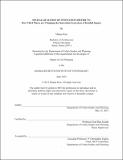Spatial qualities of innovation districts : how Third Places are changing the innovation ecosystem of Kendall Square
Author(s)
Kim, Minjee
DownloadFull printable version (9.356Mb)
Other Contributors
Massachusetts Institute of Technology. Department of Urban Studies and Planning.
Advisor
Eran Ben-Joseph.
Terms of use
Metadata
Show full item recordAbstract
This thesis analyzes the spatial dimensions of an urban high-tech cluster in the changing socio-economic landscape of American cities. Using Kendall Square as the primary case study, I analyzed the spatial qualities and characteristics that define an urban high-tech cluster and provide recommendations for how future "innovation districts" should be developed. My in depth study of the built form of Kendall Square reveals that workplaces for the high-tech industry have extended beyond the conventional office setting to include both retail and public spaces: such as cafes, restaurants; and streets, sidewalks, plazas, and open spaces. I label these emerging workplaces as "Third Places" and further emphasize that Third Places are critical catalyst to the success of innovation districts. Through my findings, I argue that urban high-tech clusters will develop from old urban areas, rather than from newly-born districts, and that such clusters will be concentrated within a walking distance of one or two transit stops, not extending beyond what could be described as a "district." Furthermore, my findings indicate that successful innovation districts are likely to develop spontaneously by incremental private real estate developments, rather than from the urban renewal era's approach of masterplanning. Comparison of the existing development projects in Kendall Square also revealed that an ideal form of innovation district is a mixed-use neighborhood that could accommodate living, working, and playing activities of everyday life. As a result of my investigation, I provide some policy and design recommendations on how to establish innovation districts. For physical spaces, I offer basic principles of designing urban spaces in a way that could stimulate social interaction, chance encounters and interfirm collaboration, which will contribute to the innovation ecosystem of a place.
Description
Thesis (M.C.P.)--Massachusetts Institute of Technology, Dept. of Urban Studies and Planning, 2013. Cataloged from student-submitted PDF version of thesis. Includes bibliographical references (p. 98-102).
Date issued
2013Department
Massachusetts Institute of Technology. Department of Urban Studies and PlanningPublisher
Massachusetts Institute of Technology
Keywords
Urban Studies and Planning.